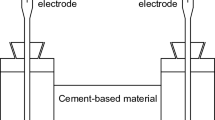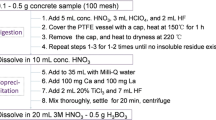Abstract
Chloride represents a major risk for reinforced concrete structures because at a certain concentration, it can promote depassivation of the steel bars and initiate corrosion. Therefore it is important to be able to measure the chloride content in concrete. In this paper the application of laser ablation inductively coupled plasma mass spectrometry (LA-ICP-MS) for the study of chlorides in concrete is proposed. This scanning technique enables quick multi-element profiling, directly at the sample without the need for further preparation, within a range of sub-millimetre (meso-scale) resolution and with low limits of detection. Optimization of the operating conditions was performed in pressed concrete powder pellets. Linearity of the calibration was verified and limits of detection below 0.05 wt% of cement were determined. Chlorine, calcium and iron distributions were studied in cement based materials of increasing heterogeneity (paste, mortar and concrete). This technique is furthermore proposed for the study of the chloride induced corrosion process, by following element distributions along the concrete-steel interface at the time of depassivation.













Similar content being viewed by others
References
Alonso C, Castellote M, Andrade C (2002) Chloride threshold dependence of pitting potential of reinforcements. Electrochim Acta 47(21):3469–3481
American Association of State Highway and Transportation Officials (1997) AASHTO-T260 Standard method of test for sampling and testing for chloride ion in concrete and concrete raw materials
American Society for Testing and Materials (2007) ASTM G109 Standard test method for determining effects of chemical admixtures on corrosion of embedded steel reinforcement in concrete exposed to chloride environments
Andrade C, Castellote M (2002) Reccomendation of RILEM TC 178-TMC: testing and modelling chloride penetration in concrete—analysis of total chloride content in concrete. Mater Struct 35(9):583–585
Angst U, Elsener B, Larsen CK, Vennesland Ø (2009) Critical chloride content in reinforced concrete—a review. Cem Concr Res 39(12):1122–1138
Becker JS (2002) Applications of inductively coupled plasma mass spectrometry and laser ablation inductively coupled plasma mass spectrometry in materials science. Spectrochim Acta B 57(12):1805–1820
Boulyga SF, Heumann HG (2005) Direct determination of halogens in powdered geological and environmental samples using isotope dilution laser ablation ICP-MS. Int J Mass Spectrom 242(2–3):291–296
Carugati G, Rauch S, Kylander ME (2010) Experimental assessment of a large sample cell for laser ablation-ICP-MS and its application to sediment core micro-analysis. Microchim Acta 170(1–2):39–45
Chaussadent T, Arliguie G (1999) AFREM test procedures concerning chlorides in concrete: extraction and titration methods. Mater Struct 32(3):230–234
Climent MA, Viqueira E, de Vera G, López-Atalaya MM (1999) Analysis of acid-soluble chloride in cement, mortar, and concrete by potentiometric titration without filtration steps. Cem Concr Res 29(6):893–898
de Rooij MR, Polder R (2005) Probabilistic approach for local chloride heterogeinity near reinforcement, in: Application of Codes, Design and Durability Regulations, 6th Internartional Congress, Theme Two: Service Life and Durability Design. University of Dundee, Scotland
Dejke V (2001) Durability of FRP reinforcement in concrete—literature review and experiments. Publication P-01:1, Department of Building Materials, Chalmers University of Technology, Göteborg, Sweden
Dhir RK, Jones MR, Ahmed HEH (1990) Determination of total and soluble chlorides in concrete. Cem Concr Res 20(4):579–590
European Committee for Standardization (1989) European Standard EN196-21 Methods for testing cement: determination of the chloride, carbon dioxide and alkali content of cement
European Committee for Standardization (2000) European Standard EN206-1 Concrete—Part 1: Specification, performance, production and conformity
Feng X, Thomas MDA, Bremner TW, Folliard KJ, Fournier B (2010) New observations on the mechanism of lithium nitrate against alkali silica reaction (ASR). Cem Concr Res 40(1):94–101
Gastel M, Becker JS, Küppers G, Dietze H-J (1997) Determination of long-lived radionuclides in concrete matrix by laser ablation inductively coupled plasma mass spectrometry. Spectrochim Acta B 52(14):2051–2059
Mori D, Yamada K, Hosokawa Y, Yamamoto M (2006) Applications of electron probe microanalyzer for measurement of Cl concentration profile in concrete. J Adv Concr Technol 4(3):369–383
Nilsson L-O, Poulsen E, Sandberg P, Sørensen HE, Klinghoffer O (1996) HETEK—Chloride penetration into concrete: State of the art—transport processes, corrosion initiation, test methods and prediction models, edited by J.M. Frederiksen, The Danish Road Directorate, Report 53
Nordtest (1999) Nordtest Method NT Build 492 Concrete, mortar and cement-based repair materials: chloride migration coefficient from non-steady-state migration experiments
Page CL (2009) Initiation of chloride-induced corrosion of steel in concrete: role of the interfacial zone. Mater Corros. doi:10.1002/maco.200805278
Pillai RG, Trejo D (2005) Surface condition effects on critical chloride threshold of steel reinforcement. ACI Mater J 102(2):103–109
Potgieter SS, Marjanovic L (2007) A further method for chloride analysis of cement and cementitious materials—ICP-OES. Cem Concr Res 37(8):1172–1175
Potgieter S, Potgieter J, Panicheva S (2004) Investigation into methods of chloride analysis of South African cement and cement-related materials with low chloride concentrations. Mater Struct 37(3):155–160
Poursaee A, Hansson CM (2009) Potential pitfalls in assessing chloride-induced corrosion of steel in concrete. Cem Concr Res 39(5):391–400
Proverbio E, Carassiti F (1997) Evaluation of chloride content in concrete by X-ray fluorescence. Cem Concr Res 27(8):1213–1223
Tang L (1996) Chloride transport in concrete—measurement and prediction. Publication P-96:6, Department of Building Materials, Chalmers University of Technology, Göteborg, Sweden
Wall H, Nilsson L-O (2008) A study on sampling methods for chloride profiles: simulations using data from EPMA. Mater Struct 41(7):1275–1281
Wilsch G, Weritz F, Schaurich D, Wiggenhauser H (2005) Determination of chloride content in concrete structures with laser-induced breakdown spectroscopy. Constr Build Mater 19(10):724–730
Yu H, Himiob RJ, Hartt WH (2007) Effects of reinforcement and coarse aggregates on chloride ingress into concrete and time-to-corrosion: part 2—spatial distribution of coarse aggregates. Corrosion 63(10):924–931
Yu H, Shi X, Hartt WH, Lu B (2010) Laboratory investigation of reinforcement corrosion initiation and chloride threshold content for self-compacting concrete. Cem Concr Res 40(10):1507–1516
Author information
Authors and Affiliations
Corresponding author
Rights and permissions
About this article
Cite this article
Silva, N., Luping, T. & Rauch, S. Application of LA-ICP-MS for meso-scale chloride profiling in concrete. Mater Struct 46, 1369–1381 (2013). https://doi.org/10.1617/s11527-012-9979-y
Received:
Accepted:
Published:
Issue Date:
DOI: https://doi.org/10.1617/s11527-012-9979-y




